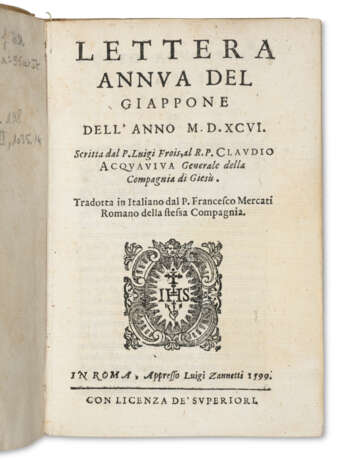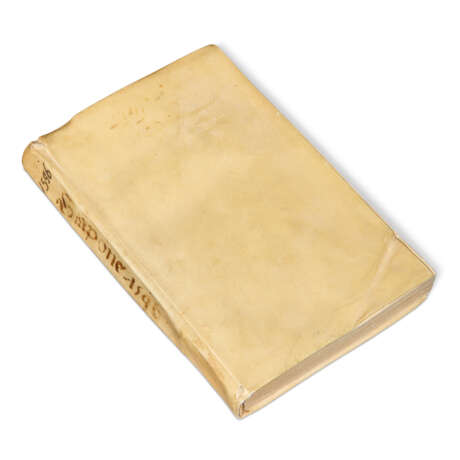ID 1450561
Lot 85 | FRÓIS, Luís (1532-1597)
Estimate value
£ 4 000 – 6 000
Lettera annua del Giappone del'anno M.D.XCVI... , translated by Francesco Mercati. Rome: Luigi Zannetti, 1599.
First appearance at auction of this Rome edition of Frois’ letter giving a detailed account of the precarious and challenging circumstances faced by Jesuits in Japan in the 1590s. Although the predominantly Jesuit Christian mission to Japan had made good progress, the grounding of the Spanish ship San Felipe on the Japanese island of Shikoku on 19 October 1596 led to a distinct change in fortunes. The ship’s pilot, Francisco de Olandia, suggested that the missionaries had been sent first to convert the Japanese to Christianity prior to a Spanish military takeover. This statement was interpreted by Japanese authorities as evidence that the missionaries were part of a broader Spanish plan for invasion, fueling Toyotomi Hideyoshi's suspicions and leading to the execution of 26 Christians in Nagasaki, known as the Twenty-Six Martyrs of Japan.
Luis Frois was among the most significant Jesuit missionaries in Japan, arriving in Omura and Miaco in 1563, where he converted numerous Japanese Buddhist priests (bonzes) to Catholicism. His missionary success led to his exile by Japanese officials to Sacoy, but in 1569, Nobunaga, the Emperor’s chief minister, permitted his return to Miaco. After several years preaching in Bungo province, Frois settled in Miaco in 1581, where Nobunaga allowed him to openly practice Christianity and even build a church. However, with the rise of anti-Christian sentiment, Frois was forced to flee to Nagasaki, where he died in 1597. Frois’s writings from Japan, including his Historia de Japan (covering 1549-1593), were highly valued for their detailed observations and served as a primary source of information about Japan for contemporary Europeans.
Three editions of this work appeared in the same year: Rome, Padua, and Milan. The Padua edition is the most frequently encountered in both the market and institutional collections. The Milan edition is extremely rare in libraries, though a copy was sold at Sotheby’s in 1988. The present Rome edition is well represented in library holdings, but no copy has been recorded at auction (RBH). Cordier Jap. 198.
Octavo (154 x 101mm). Woodcut devices on title and colophon, woodcut initials (occasional light browning and spotting). Later flexible vellum, manuscript title on spine (a little cockled, erasure to front pastedown).
| Place of origin: | Italy, Europe |
|---|---|
| Auction house category: | Books and manuscripts, Printed books |
| Place of origin: | Italy, Europe |
|---|---|
| Auction house category: | Books and manuscripts, Printed books |
| Address of auction |
CHRISTIE'S 8 King Street, St. James's SW1Y 6QT London United Kingdom | |
|---|---|---|
| Preview |
| |
| Phone | +44 (0)20 7839 9060 | |
| Buyer Premium | see on Website | |
| Conditions of purchase | Conditions of purchase |




